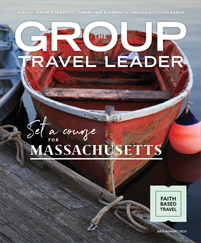Minnesota’s history hasn’t been boxed up and stored in an attic.
The past peers out on Lake Superior from atop a lighthouse that saved hundreds of sailors and ships. It’s found on the shelves of a well-preserved community grocery store and in the childhood home of the world’s most famous aviator. And it is collected and preserved in history centers from St. Paul to the Red River Valley.
Discover these unique historic sites on your group’s next trip to Minnesota.
Harkin Store
New Ulm
Setting foot in the Harkin Store on the Minnesota River near New Ulm is like stepping back 150 years. That’s when the store was in its heyday, a community hub where locals shopped, swapped news and collected their mail. Trains and a grasshopper plague destroyed not only farms and an economy that depended on river traffic but the store as well.
Thanks mainly to the preservation efforts of the Harkin family, the store has been saved, and about 40% of the goods displayed inside date from 1870 to 1901, when the store was in business, according to site manager Ruth Grewe.
“There are not a lot of old buildings that have so much original,” said Grewe. The Harkin descendants “just kept everything. Knowing the history of Grandpa’s store was important to them.”
Grewe leads a lot of tours, tailoring them to her audiences. Tourists’ questions help her decide which stories to tell. After 15 years working at the store, she has no need for a script.
People are fascinated by the goods displayed, from baby shoes and men’s heavy boots to lamps fueled by whale oil and kerosene. Many say the store reminds them of “Little House on the Prairie” — interesting, given that it is about an hour east of the Laura Ingalls Wilder Museum in Walnut Grove.
Because the store is small, larger group tours are divided in two. As one group tours the store, the other can examine photos and exhibits on the porch or wander into a gift shop so well stocked that people come just to shop there.
Consigners are locals who make honey, maple syrup, socks on a 1904 machine, mittens from old sweaters, handmade purses, wooden toys and old-fashioned games like dominoes. This year marks the store’s sesquicentennial, and Grewe advises travel planners to watch the website for special programming planned to commemorate it. Hours and days vary with the season, and the store is closed in the offseason.
Charles Lindbergh House and Museum
Little Falls
Seeing a barnstormer soar above the Mississippi River in 1911 awakened the flyer in a Minnesota farm boy who would become the most famed aviator of his time.
Charles Lindbergh lived next to the river in a modest bungalow until he was 18. Today, that home and a 1960s visitors center tell the story of Lindbergh’s life in Minnesota and far beyond.
The Charles Lindbergh House and Museum in Little Falls has perhaps the country’s largest collection of items tied to the aviator, who became an instant hero when he completed the first solo trans-Atlantic flight in 1927.
“Ninety-five percent of the items in the house are original artifacts,” said site manager Melissa Peterson. “And there are also no barriers. That is the difference of the Lindbergh House.”
Artifacts are enhanced by storytelling, much of it inspired by a 70-page letter that Lindbergh wrote for the Minnesota Historical Society in 1969 about his early years.
They are “fabulous stories that you can relate to,” said Peterson. The importance of his farm upbringing becomes clear through stories of how tinkering on tractors and other farm equipment helped him understand airplanes and their mechanicals aspects.
On days when a local bakery can supply them, groups might enjoy a treat of Lindbergh’s favorite cookie, a Swedish spritz, during a social hour in the museum. Groups can also arrange for a first-person interpretation in the 50-person theater, perhaps of a farm worker remembering life on the Lindbergh farm.
The museum’s collection covers Lindbergh’s lifetime, from the toys he played with to a replica of his famous airplane, the Spirit of St. Louis, which visitors can board to better understand what Lindbergh’s famous flight might have felt like.
A 17-minute PBS American Experience film covers the trauma he and his family faced when their son was kidnapped and explores allegations he sympathized with the Nazis during World War II.
“This is the only museum in the U.S. that covers Lindbergh in totality,” said Peterson.
Because the site’s schedule changes with the season, it is best to check the website before making travel plans. Even when it is closed to the public, group tours can be arranged.
Split Rock Lighthouse
Two Harbors
When the sky is blue and the sun is bright, Split Rock Lighthouse is picture-perfect, standing sentinel straight, nearly 200 feet above Lake Superior’s chilly waters.
But a gray, foggy day makes the North Shore landmark’s significance even clearer. Atop a 130-foot cliff, Split Rock was a life preserver. Its light, which could be seen for 22 miles, saved ships and sailors after more than two dozen shipwrecks in one storm convinced officials to build the beacon in 1905.
Thanks to modern navigation, the lighthouse, about an hour north of Duluth, was retired in 1969, but thousands of visitors come each year to take 20-minute, information-packed tours and roam the 25-acre site, climbing the 32-step spiral staircase for a top-of-the-lighthouse view. They get a close look at the French-built Fresnel lens, which is no longer in daily use, said Karly Franzen, lighthouse keeper. “The lens is still there, and it does rotate.”
Visitors can climb down the cliff to the shore for a fisheye view of the lighthouse and wander through the keeper’s cottage, where costumed interpreters talk about the isolated existence the lighthouse keeper and his family led.
“They cook on wood stoves — cookies, breads that the keeper’s family would have been making when there were kids growing up here,” said Franzen. A couple of times an hour, a recording of the lighthouse’s foghorn sounds. It’s a 10th of the volume of the real foghorn, which was “rattling-windows loud,” said Franzen.
In-season, groups can arrange their own tour when they call two weeks in advance. In the visitors center, they can watch a new film about the lighthouse’s history, although quite a few tour groups opt to buy the film and watch it on the motorcoach as they travel, according to Franzen. Interiors of the lighthouse and other buildings are closed in the winter. The lighthouse reopens in mid-March but doesn’t offer guided tours until the season begins in mid-May.
Historical and Cultural Society of Clay County
Moorhead
The Historical and Cultural Society of Clay County is best known for two striking re-creations, both tied to Nordic culture: the Hjemkomst Viking Ship and the Hopperstad Stave Church.
Those two replicas, coupled with the name of the society’s museum — the Hjemkomst Center, Norwegian for “welcome” — have led to the assumption that the society is all about Scandinavian heritage.
“Those things do tend to make people think we are a Scandinavian heritage center, but we are not,” said Maureen Kelly Jonason, executive director. “We are the Red River Valley Heritage Society really, which means we look at issues of diversity.”
A good example is the center’s Pangea festival in November.
“It is a free multicultural showcase of culture and arts of many different nations because Fargo [Moorhead’s twin city across the river] is a refugee resettlement community,” said Jonason. “There is a lot of diversity here that people don’t normally associate with this region.”
Pangea is one of four cultural festivals held at the museum each year; groups can build a tour around any of them. Celtic culture is celebrated in March. In June, there’s a Scandinavian festival. September brings a German celebration.
“The festivals are a fun time to let people loose to enjoy food, music and culture,” said Jonason.
The Hjemkomst Center also brings world-class traveling exhibits to the region. It was the only Minnesota site for Quilt National 2019, held July 1-Sept. 30, an exhibition of 32 art quilts by some of the world’s finest fiber artists. The biennial exhibition appeals to local quilt enthusiasts. “There is a big quilt subculture here, but people who are not obsessed with quilts will find it fascinating. These are not your grandma’s quilts,” said Jonason.
This year’s exhibitions conclude with a League of Women Voters women’s suffrage exhibit, which celebrates the 100th anniversary of women’s suffrage. That exhibit will be enriched with the history of the league’s local chapter.
Minnesota History Center
St. Paul
The Minnesota History Center has found that oldies often are goodies in terms of exhibitions.
“One of our most popular with tour groups is the ‘Minnesota’s Greatest Generation’ exhibit,” said museum manager Annie Johnson. “It has been here about a decade now, but it is still going strong.”
Told through the stories of Minnesotans and artifacts collected within the state, the exhibition takes visitors through the difficult days of the Great Depression and World War II to the boom times of the 1950s and 1960s.
The center is known for interactive experiences, like sitting inside the fuselage of a C-47 troop transport plane to hear recordings of Minnesota paratroopers who survived D-Day.
Group tours, scheduled at least two weeks in advance, include a greeting and a guided tour of an exhibit of the group’s choosing. Then, the group can choose how to spend the rest of its visit.
A good choice for music lovers is “First Avenue,” a look at the impact of a tiny music venue that brought future stars like Joe Cocker, the Replacements and Prince into the spotlight. This year is First Avenue’s 50th anniversary. “We have one of Prince’s outfits from Purple Rain, so that is always a hit,” said Johnson.
Another exhibition, which opened in late 2019, represents a new relationship the center has forged with the state’s Native American tribes. “Our Home: Native Minnesota” blends personal stories, loaned art, and artifacts and pieces from the museum’s collection to tell stories of the Ojibwa and Dakota tribes. “It is our first exhibit to focus on Minnesota’s Native American story of survival, resistance and adaptation,” said Johnson. In September, another new exhibition will open to tell the story of women’s suffrage through Minnesotans’ experience.












